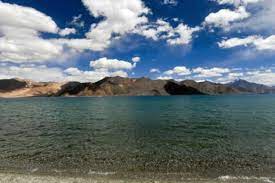China Building a Second Bridge On The Pangong Tso Lake:

The Ministry of External Affairs has confirmed that China is building a second bridge on the Pangong Tso lake.
- The site of the bridge is around 20 km east of Finger 8 on the lake’s north bank – where the Line of Actual Control (LAC) passes.
- However, the actual distance by road is more than 35 km between the bridge site and Finger 8.
- The construction site is just east of Khurnak Fort, where China has major frontier defence bases.
- China calls it Rutong Country.
- It has a frontier defence company at the Khurnak Fort, and further east, a water squadron deployed at Banmozhang.
- Although it is being built in territory that is under China’s control since 1958, the exact point is just west of India’s claim line.
- The Ministry of External Affairs considers the area as illegally occupied by China.
- The bridges are at one of the narrowest points on the lake, close to the LAC.
- These constructions will connect both sides of the lake, which would significantly cut down time for the People’s Liberation Army (PLA) to move troops and armored vehicles.
- The induction of troops from the G219 highway (Chinese national highway) would come down by 130 km due to this bridge.
Pangong Tso
- Pangong Tso is a 135-km long landlocked lake located at an altitude of over 14,000 feet i.e., 4350 m above sea level.
- Indian and China have around one-third and two-thirds of Pangong Tso Lake respectively.
- India has around 45 km of Pangong Tso under its control while approximately 60% of the lake, in terms of length, lies in China,
- The eastern end of Pangong Tso lies in Tibet.
- The lake, a glacial melt, has mountain spurs of the Chang Chenmo range jetting down, referred to as fingers.
- It is one of the highest altitude lakes in the world that is filled with saline water.
- However, even though it is a saline water lake, Pangong Tso freezes completely.
- The brackish water of this region has very low micro-vegetation.
- No aquatic life or fish, except crustaceans during winters are found.
- It is a kind of endorheic basin, which implies that it retains its water and does not allow outflow of its water to other external water bodies, such as oceans and rivers.
- Pangong Tso is popular for its changing colour ability.
- Its colour changes from shades of blue to green to red.




